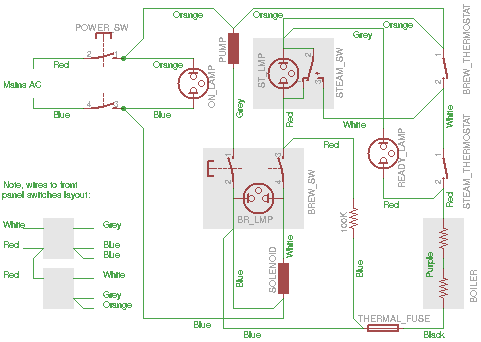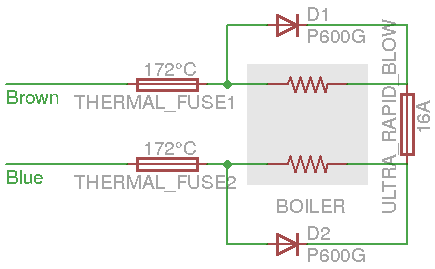[Update: in my rev 2 PID controller board, I am going to move the logic below onto the PCB. But for any controller which was not designed with this in mind, including the disc thermostats, the design below should work. As long as the controller can handle double the current through its switching circuit.]
Some time back, I pondered whether it might be possible to increase the boiler power of my Gaggia Baby Class so it heats up more quickly. I subsequently carried out the plan and love it. Here is what I did…
The coffee machine’s boiler cleverly has two elements which can be wired in parallel for countries with a 120VAC mains power supply and in series for countries with 240VAC mains power. Both configurations give a power of around 1.35kW. You can see this in the bottom right corner of the schematic below (download PDF):
If, however, you live in a 240VAC country, as I do, you could use the parallel wiring to get four times the boiler power (double the voltage means four times the power). That sounds interesting but it is impractical and dangerous: the maximum fuse size for a normal UK mains plug is 13A. Still, at 13A, we can nonetheless have twice the power, 2.7kW – but how to wire the elements? The answer is fairly simple: put a diode in parallel with each element so that the elements only conduct electricity for half of each mains AC cycle. The other half of the cycle, the diode shorts the element. The net effect is a doubling of the original 1.35kW to 2.7kW.
As discussed in the post on safety, this needs protecting with a quick blow fuse and thermal fuses. Taken all together, here is a schematic of the new boiler wiring (PDF here):
Installation notes
I used an in-line fuse adaptor for the quick blow fuse.
I wired the diodes into the circuit with chocolate block connectors. The diodes also needed heat sinks. Conveniently, I found I could fit a TO-5 heat sink around each diode.
I used chocolate block connectors again for the thermal fuses, but I removed and discarded the outer plastic covers, using just the metal bits. Copying the original Gaggia method, I shrouded the thermal fuses and connectors with silicone tubing. The boiler has mounting points for both thermal fuses, although it only shipped with one fuse. I had to bend a bit of metal into shape to make a retaining clip for the second thermal fuse.
The boiler’s terminals have special connectors, but standard spade terminal connectors can be made to do the job with a little bending.
Everything else is held together (naturally) with cable ties.
This is what it looks like installed:
Note, the diode leads are covered in black heat-shrink, so they’re hard to see. They are there, really.
Two more shots from different angles:
Parts
I bought all my parts from CPC, so here are links to what I used:





Thank you! I got no notification of your reply but now see you made an update with all the needed information. Thank you again
You’re welcome.
I’m experimenting with a comment reply notification plugin now.
Would this also work for the gaggia classic?
Yes, absolutely. Unless it is quite a new model – I think there is now a lower power boiler that supposedly meets new laws designed to reduce electricity use. (The daft thing being that a higher power boiler actually reduces electricity use because it minimises the time you have the machine switched on!)
Anyway, if your boiler looks like the one in my picture, you’re good to go. But be careful you don’t melt or burn anything!
Hi Tom,
I found your blog via googling for dual voltage espresso machines.
I moved from USA to Brazil, which is a 220v country. Prices for consumer goods is high, and selection somewhat limited.
I’ve wondered if there is a generalized method of modding a 110v appliance power supply for 220v – particularly a prosumer espresso machine and grinder ($1500-2500 price range).
I have an auto-transformer, but I’d really rather make a permanent mod, and I’m handy with a soldering iron.
Got any suggestions? Thanks!
Unfortunately there is no general solution other than using something like a transformer. For some products the components are designed just to work at one voltage. This is often the case for motors (e.g. in a grinder) or for heating elements, etc. Other products are designed to work at more than one voltage, perhaps with some wiring changes or changing a switch setting, etc.
The Gaggia Classic boiler is one item that is designed to work at either 110V or 220V with just a wiring change. But even these Gaggia machines have a pump which would have to be replaced for a different voltage.
So your machines may or may not be easy to mod. If you can get a circuit diagram that would help you. In addition to motors, elements, etc. other things especially to watch out for when going from 110V to 220V are switches, thermal switches, fuses, FETs, TRIACs, etc. which might only be rated to block 110V when switched off. (In the other direction you are mainly looking to see whether the components can handle twice the current since anything that can handle 220V can also handle 110V).
Appreciated!
I don’t want to risk ruining a $2k investment due to my naive PS mod skills. Unless I find a good 220v machine, will go with step-down transformer.
Inconvenient but probably the best solution.
Hello!
Im ezequiel.
Like Len h. I bought a Gaggia classic pro in USA, and im traveling to Argentina.
Because of the prices in argentina, i want to keep my expresso machine.
I was searching in a lot of forums, and i see that some people saids that a transformer of 110v to 220v will not work because of 50 / 60Hrz Issue, and other people said like it will work, but a little “Slow” or “different”.
I know somthing of electronic, so i was trying to find schematics, to see if there is any internal transformador, to change it inside the machine and make it 220v easier, but like u said earlier, this machine has a lot of analogic thinks that only works on 110v, i have to change a lot of thinks to do it internal, so its not a choice.
Question. With a external 110-220v transform it will works? or because of the 50/60 hrz mybe will burn it?
——————————————
ESP:
hola!
Soy ezeuiql
Como Len H. Compre una gaggia classic pro en USA y estoy viajando a argentina
Debido a los precios en Argentina, estoy intentando mantener mi maquina de expreso.
Estuve buscando en muchos foros, y vi que la gente dice que un transformador de 110v a 22v no va a funcionar por la diferencia de 50/60Hrz, otras personas dicen que si funcionará, pero d”iferente” o “mas lento”.
Se algo de electronica, entonces estaba intentando buscar los esquemas de la cafetera, para ver si hay algun transformador interno para cambiar facil a 220v, pero vi que tiene varias cosas analogicas que solo andan en 110v, entonces me parece que no es una opcion.
Pregunta: Con un transformador 110v-220v Funcionará? o el hecho de 50/60Hrz va a hacer que se queme?
I don’t know the Gaggia Classic Pro specifically. Does it look like these parts diagrams inside? If so, it appears to be a standard Gaggia Classic from an electrical point of view. There are no electronic components in there, only mains voltage electrical. So…
50/60Hz is not likely to make much difference. The pump speed will be a little different, but I think that’s it.
In terms of voltage, the boiler can be rewired for a different voltage. The pump and solenoid probably need replacing. Neon lights might also be specific to one voltage. My guess is all the switches and disk thermostats are rated for at least 240V / 10A and will work on any supply.
So rewiring and replacing some parts is an option but unless you really know what you’re doing, a transformer is probably the way to go. Make sure it can handle more than 1.5kW, though.